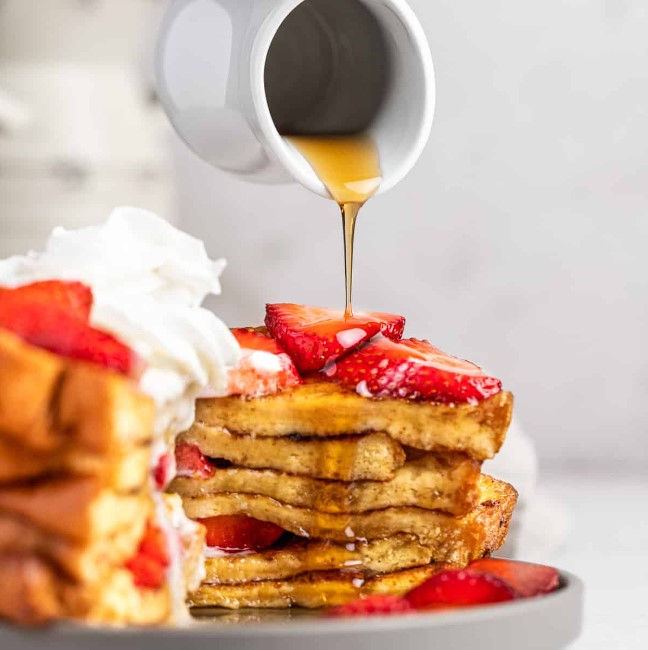Introduction to Buttermilk French Toast
Buttermilk French Toast, a dish beloved across generations and cultures, has a rich history that dates back to ancient times. Originally known as pain perdu or “lost bread” in France, this dish was a practical solution to revitalize stale bread. Over the centuries, French toast has evolved, embracing diverse culinary traditions and ingredients.
The introduction of buttermilk as a key ingredient in French toast is a relatively recent innovation that has transformed the dish’s texture and flavor. Buttermilk, with its slightly tangy and rich profile, adds a unique dimension to the classic recipe. Unlike regular milk, buttermilk imparts a subtle tartness, enhancing the overall taste and creating a more complex flavor profile. This delightful twist not only honors the traditional essence of French toast but also elevates it to a gourmet level, making it a favorite in modern brunch menus and home kitchens alike.
For a detailed recipe using buttermilk, check out Epicurious’ Buttermilk French Toast Recipe.
Benefits of Using Buttermilk
Buttermilk is not just a flavorful addition to French toast; it also brings several nutritional benefits. Rich in vitamins and minerals, buttermilk is lower in fat compared to regular milk, making it a healthier option for those mindful of their dietary intake. It contains probiotics, which are beneficial for gut health and digestion.
From a culinary perspective, the use of buttermilk in French toast significantly enhances both flavor and texture. The acidity in buttermilk tenderizes the bread, allowing it to absorb the mixture more effectively, resulting in a softer, more custard-like interior. This contrasts beautifully with the crispy, golden exterior achieved when the toast is cooked. The tangy flavor of buttermilk also adds depth and complexity, balancing the sweetness of traditional toppings like maple syrup or powdered sugar. These attributes make buttermilk an excellent choice for creating a French toast that is both delicious and satisfying.
Recipe and Preparation
Choosing the Right Bread
The choice of bread is a critical factor in creating the perfect French toast. Ideal bread types are those that are dense and sturdy enough to absorb the buttermilk mixture without falling apart. Challah and Brioche are top choices due to their rich, buttery texture and ability to hold their shape. These breads have a soft crumb that soaks up the liquid beautifully, resulting in a moist interior after cooking.
Sourdough and Texas toast are also excellent options. Sourdough brings a delightful tanginess that complements the buttermilk, while Texas toast, with its thick slices, provides a hearty base for the custard mixture. Avoid using very fresh or soft bread as it can become too soggy. Day-old bread is preferable as it has slightly dried out, making it more absorbent and less likely to disintegrate when soaked.
For more insights into choosing the right bread, visit Jamieson Diaries’ Buttermilk French Toast.
French Toast : Variations and Serving Suggestions
Creative Variations
French toast is a versatile dish that lends itself to a variety of creative twists. Adding flavors to the buttermilk mixture can elevate the dish to new culinary heights. A teaspoon of vanilla extract can impart a sweet, aromatic flavor, while a dash of cinnamon or nutmeg adds warmth and spice. For a citrusy zest, consider grating some orange or lemon peel into the mix.
For those looking to experiment beyond traditional buttermilk, there are several alternatives. Almond milk or coconut milk can be used for a dairy-free version, adding their own subtle flavors. To mimic the tanginess of buttermilk, add a tablespoon of lemon juice or vinegar to regular milk and let it sit for a few minutes. This homemade buttermilk alternative works wonderfully in French toast, providing a similar texture and taste to the original recipe. These variations allow for personalization and can cater to different dietary needs or flavor preferences.
FAQs
Can buttermilk be substituted in French toast?
Yes, buttermilk can be substituted in French toast, and it’s a fantastic way to add a unique flavor and texture. If you don’t have buttermilk, you can easily create a substitute by adding a tablespoon of lemon juice or white vinegar to a cup of regular milk and letting it sit for about 5 minutes. This mixture won’t be as thick as traditional buttermilk, but it will provide a similar tangy flavor. Additionally, dairy-free alternatives like almond or soy milk mixed with an acid (lemon juice or vinegar) can also be used for those avoiding dairy.
Tips for making French toast not soggy.
To prevent your French toast from becoming soggy, consider the following tips:
- Use thick, dense bread like Challah or Brioche, and if possible, use day-old bread as it absorbs the egg mixture better without becoming too mushy.
- Don’t over-soak the bread. Dip each slice in the buttermilk mixture just long enough to coat it, letting excess liquid drip off.
- Cook the French toast at a medium heat. High heat can burn the exterior before the inside is done, while low heat can cause the bread to become too soggy.
- Ensure your cooking pan or griddle is properly heated before adding the bread. A well-heated surface helps in cooking the exterior quickly, sealing in the moisture without making the bread soggy.
Freezing and reheating instructions.
French toast can be frozen and reheated, making it a convenient make-ahead meal. To freeze, cool the cooked French toast and then place the slices in a single layer on a baking sheet. Freeze until solid and then transfer to a freezer-safe bag or container. They can be stored for up to 3 months.
To reheat, place the frozen French toast in a toaster or an oven preheated to 350°F (175°C) until warmed through and crispy. This usually takes about 5-10 minutes. Avoid microwaving as it can make the toast soggy.
Conclusion
Buttermilk French toast is a delightful twist on a classic breakfast dish. Its rich flavor and creamy texture make it a favorite for brunches and special occasions. Experiment with different bread types and toppings to find your perfect combination.
For more breakfast ideas, explore our Anabolic French Toast for a fitness-friendly option or try our unique French Toast Pancakes for a delightful twist on classic breakfast favorites.



